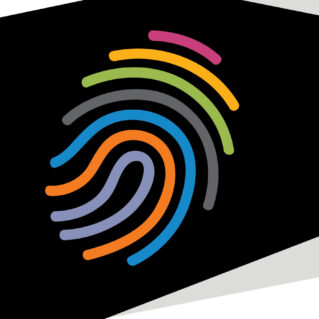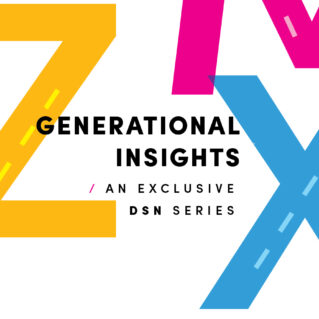Improve customer acquisition and increase brand loyalty by following these simple strategies

The way we shop has changed dramatically since 2020. Direct-to-consumer (DTC) brands are reconfiguring the way we purchase everything from clothes to furniture to groceries to personal care products. In fact, more than half of U.S. internet users have already purchased from a DTC personal care or beauty brand with the entire industry projected to surpass $716 billion in revenue by 2025 according to commonthreadco.com.
While the pandemic accelerated this trend, it did not cause it. The emergence of DTC brands has been fueled by social media with influencer marketing and effective digital marketing strategies. A huge component of those strategies are customer referral programs. And there are many lessons for direct sellers within these programs.
Direct selling is built on word-of-mouth marketing. How those referrals are made continues to evolve as face-to-face meetings take a back seat. Sampling and referrals for direct selling still has a bit of an identity crisis—the methods aren’t as simple, intuitive and prompted as they should be. But by following the blueprint established by DTC brands, companies can set a successful standard for our channel.
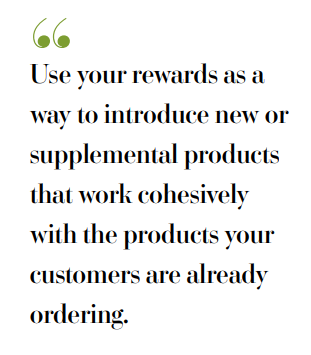
The goal is for these customer-focused digital, mobile and social selling systems to be seamless and automatic. There are many benefits of successful referral programs, including:
- A lower cost per customer acquisition than traditional marketing efforts;
- An opportunity to organically increase brand loyalty and awareness;
- A chance to establish immediate legitimacy;
- Opportunities to cross-sell and up-sell.
To put it plainly, referral programs are so beneficial to direct selling companies because they work. According to getambassador.com, as of 2021, 74 percent of people say word-of-mouth is a key influence on purchasing decisions, and 92 percent of 18-34-year-olds actively seek out product recommendations prior to purchase. Referrals are especially powerful for health and wellness products because people have concerns about the efficacy and quality of products they consume.
Direct selling is inherently adept at leveraging word-of-mouth recommendations for products, but this also can translate to the opportunity. Crowd-source companies like Uber utilize referrals to recruit new drivers. Current drivers can refer a friend to join, and, once that friend completes a certain number of trips, both receive rewards. As traditional recruitment models in our channel continue to come under scrutiny, this option can be game changing.
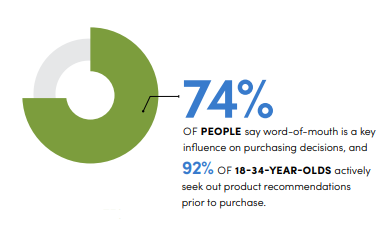
These programs also provide a way for companies to stand out in a crowd and reinforce their brand’s mission and message, something that’s increasingly important to consumers. According to businesswire.com, 46 percent of consumers consider a brand’s social responsibility efforts when purchasing, and generational expert Jason Dorsey reported that Gen Z is particularly motivated by social causes. At Tesla, owners can earn awards when friends and family use their referral link to order select products. The brand emphasizes their commitment to sustainable energy through the rewards they offer, providing substantial discounts off solar panels and solar roofs.
Five things every direct selling referral program must do
Of course, your referral program should be as unique as your brand, but there are a few key elements that must be addressed across the board, regardless of product line, incentive plan or strategy. Here are five key elements every successful direct selling referral program needs.

- Keep it simple, straightforward and streamlined
A key component of a successful program is to make it frictionless and user friendly. The goal is to remove any and all barriers to making a fast, low-effort referral. One company excelling in this regard is Athletic Greens. They start the process instantly—providing an auto-populated text for referrals before customers even make a purchase. Referrers literally have to do nothing but provide an email address and click a button to share their interest with friends and family. - Incentivize, but know what motivates your customer base
A/B testing gave AirBnB invaluable insights after they launched their referral program. Their initial offering was a cash reward to the referrer when their friend took a trip or rented out a home. They tweaked the messaging and rewards, discovering that engagement improved when the reward went to the recipient rather than the person making the referral. Now, the offer is gifting a friend $25 off when they book with AirBnB. - Manage your costs
Giving cash rewards can be expensive—remember that there are all types of “currency” you can offer. Consider gifting under-performing SKUs or offer credits or bonus loyalty points redeemable in your online store (a simple way to drive traffic and gain revenue at the same time). - Spread the word
A referral program is only as good as the buzz surrounding it. Promote yours through your home page, social media platforms, email campaigns, press releases and on your app. Make referral opportunities easy and hard to miss when interacting with your brand. And don’t be afraid to do something extra special and valuable for a limited time. Pre-launch, shaving giant Harry’s offered incremental rewards to people who were willing to refer their friends through email, Facebook or Twitter. The offer was simple: refer 10 friends, earn a free razor. Refer 25 friends, earn a free premium razor. Refer 50 friends, earn free shaving for a year. The promotion lasted a week and generated 100,000 leads. - Track and tweak
Many companies keep their referral programs fresh by consistently updating their rewards and offers. Experimenting with new incentives and taking a deep dive into the analytics allow them to let the program breathe and become more impactful and appealing over time. Make sure you track the effectiveness of your program by using dynamically generated links and codes. And keep track of the following key metrics: number of new members generated; number of site visitors converted; number of referrals generated and on what channels; how many new customers acquired; and cost per acquisition.
Make the Rewards Memorable
It’s clear that incentivizing customer referrals is key to making these programs successful—that’s why virtually every brand offers some sort of enticement for making or acting on a referral. It’s imperative that your rewards offer something special to distinguish them from the crowd. Consider these factors when designing your program.
For the Referrer
“Membership has its privileges” was a legendary marketing campaign for American Express back in the ’90s. And that premise still holds true. These are your most vocal and passionate brand advocates—make sure the incentives you offer validate and reward that. Keep these four factors in mind.
Exclusivity
Tesla frequently tweaks its referral program, but one of the rewards it has offered in the past included entry to exclusive events or vehicle accessories that weren’t available any other way. What exclusive experience or limited-edition items can you offer to your most active referrers? If the reward is special enough, the desire to earn it could translate to a lot of leads.
Supplemental / targeted samples
Use your rewards as a way to introduce new or supplemental products that work cohesively with the products they are already ordering. Think an eye cream that works synergistically with a daily moisturizer or a new lipstick shade that complements their favorite nail polish or eye shadow palette. When your product samples are purposeful and tailored to the recipient, you are much more likely to increase sales.
Seasonal
You don’t want referrals to be a one-and-done proposition. Encourage continual engagement by offering seasonal items as limited-time rewards. A summer-y citrus drink flavor or anything pumpkin spice scented when fall rolls around helps keep your rewards program fresh, top-of-mind and relevant to your followers throughout the year.
Progressive (refer more / get more)
It’s easy to refer one friend—harder to refer 2, 3 or 10. Make sure the value of your rewards increases with the number of successful referrals and keep it as easy as possible for your advocates to track their progress. Basic Dropbox customers get 500MB of storage added to their account for each referral, up to 16 GB. The friend they referred also gets 500MB. They also have a handy status bar so customers can see how much they’ve earned t date—instant motivation!
For the Refer-ee
You’ve managed to get their attention with the help of their friends or family through your referral program. Now, what can you do to seal the deal and turn that lead into a loyal brand fan? Here are three guiding principles.
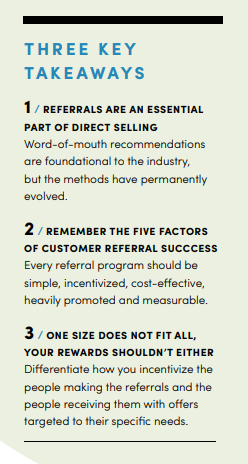
Sample
There’s no better way to turn a prospect into a customer than by letting them try the product Provide single-use samples of your best sellers that offer an immediate benefit or multi-day samples for products with incremental results.
Unobtrusive
It’s important to remember that these potential customers didn’t seek your company or products out. Respect their time and privacy by not bombarding them with constant or complicated communications. Keep your messages short, benefit-oriented and limited in number.
Unexpected
As a company, you should always strive to “surprise and delight.” Consider offering something unexpected, useful and branded with a customer’s first order. But make sure the item works synergistically with your products: a measuring tape so customers can easily follow your size guide; a reusable straw for their energy drink; or stirrer for their coffee.
Most companies in the channel have some sort of referral program, but many are unremarkable, underpromoted or difficult to use. Simply revamping your offers or messaging could give yours an immediate boost.
From the August 2022 issue of Direct Selling News magazine.
